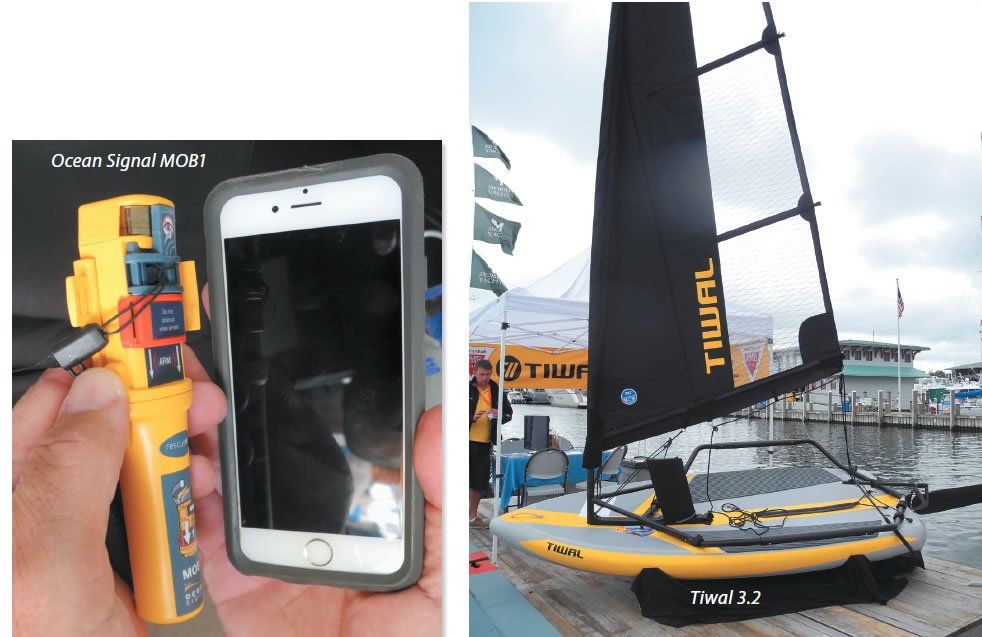When we plan what to put in each issue of Practical Sailor, we ask ourselves, Whats new in the sailboat industry? But of equal importance is considering the products that have weathered the test of time, evolved into a better product, or arrived in the marine market place from a non-marine manufacturer. This years United States Sailboat Show in Annapolis, Md., had answers to all of the above.

Ocean Signal MOB1
Ocean Signals new MOB1 is the smallest Automatic Identification System (AIS) beacon on the market today, and in addition to containing a 66-channel GPS, the beacon also transmits a VHF signal that sets off nearby Digital Selective Calling (DSC) alarms-a great tool in the event the wearer goes overboard. Theres even a built-in strobe, and with all of the signals operational, the units Lithium battery affords a 24-hour minimum operation time.
Vessels equipped with both AIS and DSC equipment will receive signals on each of these systems. The self-deploying antenna and automatic activation result in the first distress signal propagating within 15 seconds. An audible alarm is issued from the VHF, and a visual position of the man overboard appears on the AIS screen and wherever the AIS signal has been networked.
The waterproof unit clips onto the oral inflation tube of an inflatable lifejacket. Battery life is listed as seven years, and there is a five-year warranty. The transmit power (EIRP) of the AIS is 1 watt, and the EIRP of the DSC signal is a half-watt. The MOB1 weighs 3.2 ounces and is 5.3 inches in length. The maker suggests that users with older AIS and DSC equipment check with the equipments manufacturer to be sure the MOB1 is compatible with the older gear. ($260, www.oceansignal.com)
Honda WX10K1A
Hondas micro mini WX10K1A is a lightweight, aluminum, four-stroke, gasoline-powered, easy-priming pump that weighs only 13.4 pounds, but it delivers a respectable flow rate of 30 gallons per minute at 12 psi with a total lift-head of 25 feet. The input and output connections are handy, 1-inch NPT fittings, and the pump can be used for dewatering, washdown, and water transfer. Its compact size allows it to be tucked away in a small locker, and with the included garden-hose adaptor attached, its a handy tool for a serious deck washdown. It should be noted that Honda does not recommend this for salt water use. Our tech staff believes that a freshwater rinse after each salt use will prevent any harm–however this could void the warranty.
The pump comes complete with a 16.5 feet of suction hose with a strainer, plus 50 feet of discharge hose and a garden-hose adaptor. The 25cc, mini four-stroke engine is easy to start, and it takes 80 seconds for the pump to self-prime with a 16.4-foot head. As with all pumps, output pressure and flow volume are indirectly proportional; increasing pressure reduces water flow, and the opposite is also true. When using the pump to deliver a washdown spray, higher pressure and lower volume work just fine, but when dewatering is the job at hand, lower pressure delivers more flow volume, and lessening the lift height and bends in hoses makes sense. The unit has a three-year warranty. ($400, www.powerequipment.honda.com)

Tiwal 3.2
The Tiwal 3.2 is a breakthrough, small, performance sailboat that packs up into two bags full of great fun and impressive performance. The genius lies in how the boat has been engineered. A quick-to-assemble, tubular-aluminum framework becomes both a hiking rack and a rigid support for the mast step, dagger-board, rudder, and mainsheet. The well-reinforced, PVC inflatable hull incorporates dropstitch reinforcement between the deck and the bottoms multi-polymer layers. The tensioning of this inner network of parallel filaments is accomplished with just 11 psi of air pressure, and the net result is a stiff hull and load-bearing framework. The Tiwal planes in 10- to 15-knot conditions and can carry up to 220 pounds of adults and kids having fun in light air or in breezier conditions.
The launch sequence takes only about 20 minutes and begins with the unpacking and partial inflation of the hull. A rechargeable, battery-powered air pump makes quick work of what could be a foot pump workout. Next comes the insertion of the daggerboard trunk/central frame component. Then theres the click-together assembly of tube sections to complete the fame, which is strapped to the inflatable hull using four convenient, self-stick webbing straps. Finally, with the hull pressure topped off and a five-piece carbon spar slipped together, youre ready to step the mast (with the 5.2-meter or 7-meter sail set), run the mainsheet, set the rudder, and launch the boat. The Tiwal has a two-year warranty. ($5,950, www.tiwal.com)
Ocens Sidekick
Ocens provides efficient data compression and file transfer routines to make the slow speed of satellite-phone data transfer more efficient. Its compressed WeatherNet gridded binary files (GRIB) can be received worldwide using Iridium, Inmarsat, Globalstar, KVH, and other satellite-communications hardware. GRIB Explorer for iPad gives inshore and coastal sailors a weather and oceanographic resource that can be acquired via satellite off network link. The latest addition to the companys lineup is the Ocens Sidekick satellite Wi-Fi router.
The Sidekick links your Wi-Fi-enabled tablets and smartphones to a satellite telephone without serial connections and USB port configurations. Perhaps, the most useful add-on is the Sidekicks firewall that prevents the download of background data that can extend download time and provides no additional detail. The device is useful in general messaging, email, and weather GRIB file download modes. It is designed to be used with the other Ocens products mentioned above. ($99, www.ocens.com)
Xaxero Weather Fax 2000
For those with an already-installed SSB transceiver or good-quality SSB receiver, theres a cost-effective way to acquire near-shore and offshore weather for a significant portion of the Atlantic and Pacific (other nations also offer such free WEFAX forecasts). In the U.S., this weather information is provided by the Ocean Prediction Center and National Hurricane Center, and these agencies are the gold standard for high-seas weather information.
The hardware/software kit is SeaTech Systems Xaxero Weather Fax 2000, which comprises a demodulator that houses a microprocessor. Cables to connect an audio output to the demodulator and a USB cable to complete the link to a PC laptop are also included. Software is downloaded from a disc, and the user is guided to a specific WEFAX station and broadcast times to receive weather graphics and text products (NAVTEX).
The bottom line is that it takes a little more effort to establish when signal propagation will be best and which frequency to use. But the information that can be accessed is current and vetted by highly experienced meteorologists. It is also free of charge, and as the cost of satellite time continues to increase, this certainly remains an issue. It is also a valid backup means of gaining valuable forecast information. ($199, www.sea-tech.com)

































